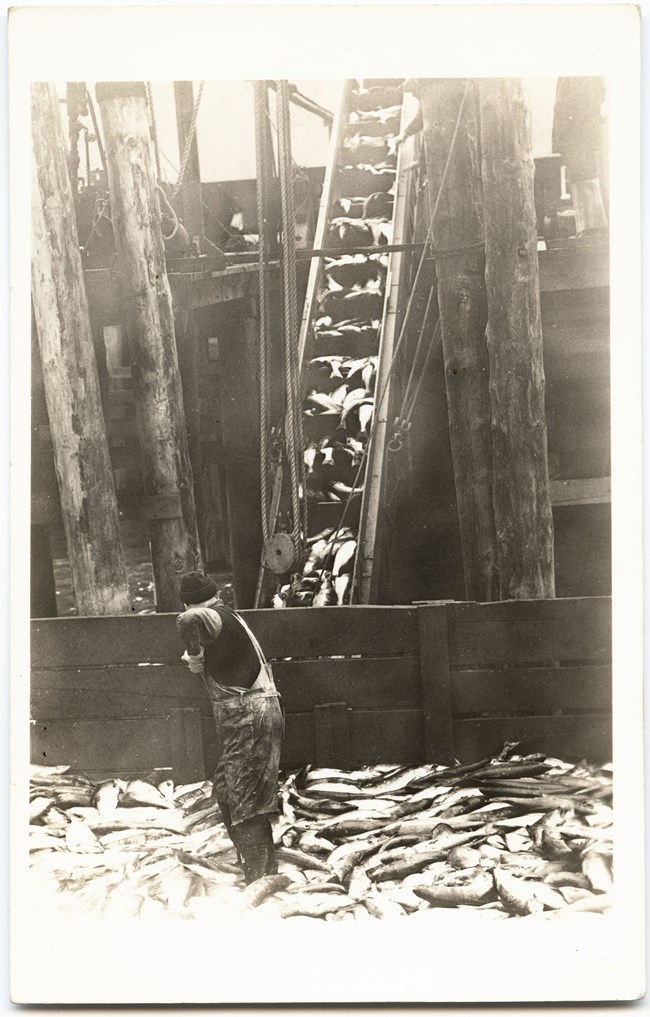Part of a series of articles titled Canneries of Alaska.
Previous: Kukak Bay Cannery
Article
Bristol Bay has a high concentration of canneries due to the high volume of salmon; all five species of salmon are present in the region. The salmon migrate from the bay up the rivers to their spawning grounds in the glacial lakes, providing a renewable resource. The Yup’ik, Alutiiq, and Dena’ina subsisted off the salmon runs for 9,000 years.

NPS Photo / San Francisco Maritime Digital Museum Archival Collection (SAFR 21374)
The Arctic Packing Company constructed the first saltery in Bristol Bay at Kahulik in 1883. The following year, the saltery was converted into a cannery and it produced a pack of 400 cases. By the 1880s, there were four canneries operating in Nushahak Bay, and by the end of 1890, canneries had developed in other parts of Bristol Bay including Naknek River and Kvichak River. In 1901 the total pack for the bay was 719, 643 cases; nine years later the bay produced 914,138 cases accounting for 40% of Alaska’s total salmon pack. Between 1884 and the 1950s, 45 canneries had operated in the area, some working directly across the river from each other.
This highly competitive market created a new culture that altered the region forever. These new companies exposed Native Alaskans to western styles, and introduced them to the wage economy. This also exposed the Native population to new diseases, such as the Spanish Flu of 1918 that affected a large portion of the population. The development of the canneries also hampered the salmon runs in the late 1880s. The canneries overfished the area, which affects the subsistence lifestyles of the Dena’ina people upstream. The use of fish traps prevented the movement of salmon upstream to their spawning grounds. If fishing had continued in this manner, the salmon would have become extinct. This ultimately led to the regulating of fish traps and the outlawing of barricades in the water.
In the 1930s, there were 19 canneries in operation at Bristol Bay. Between them, they packed 1,739,677 cases in 1934. In 1943, the canneries packed 1,320,286 cases. The number of cases varied greatly year to year, as did the number of operating canneries. In 1947 there were 17 canneries in operation, decreasing to 14 in 1950, and by 1959 only eight were still operation.
| Date | Event or History | Owner | Pack |
|---|---|---|---|
| 1883 | First saltery, at Kahulik | Arctic Packing Company | - |
| 1884 | Converted to cannery | - | 400 cases |
| 1890 | By this time, canneries had developed in other parts of Bristol Bay | - | - |
| 1901 | - | - | 719,643 cases (for whole bay) |
| 1910 | Produced 40% of Alaska's total salmon pack | - | 914,138 cases (for whole bay) |
| 1884-1950s | 45 canneries had operated in the area during this period | - | - |
| 1930s | 19 canneries in operation | - | 1,739,677 cases (in 1934) |
| 1943 | - | - | 1,320,286 cases |
| 1947 | 17 canneries in operation | - | - |
| 1950 | 14 canneries in operation | - | - |
| 1959 | 8 canneries in operation | - | - |

Alaska Packers Association and US Coast and Geodetic Survey (Alaska State Library Historical Collections, ASL-MS80-Map-52)
Part of a series of articles titled Canneries of Alaska.
Previous: Kukak Bay Cannery
Last updated: November 5, 2019